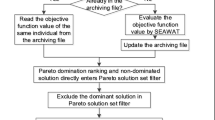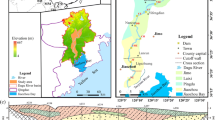Abstract
Seawater intrusion (SWI) is a widespread environmental problem, particularly in arid and semi-arid coastal areas. Therefore, appropriate management strategies should be implemented in coastal aquifers to control SWI with acceptable limits of economic and environmental costs. This paper presents the results of an investigation on the efficiencies of different management scenarios for controlling saltwater intrusion using a simulation-optimization approach. A new methodology is proposed to control SWI in coastal aquifers. The proposed method is based on a combination of abstraction of saline water near shoreline, desalination of the abstracted water for domestic consumption and recharge of the aquifer by deep injection of the treated wastewater to ensure the sustainability of the aquifer. The efficiency of the proposed method is investigated in terms of water quality and capital and maintenance costs in comparison with other scenarios of groundwater management. A multi-objective genetic algorithm based evolutionary optimization model is integrated with the numerical simulation model to search for optimal solution of each scenario of SWI control. The main objective is to minimize both the total cost of management process and the total salinity in aquifer. The results indicate that the proposed method is efficient in controlling SWI as it offers the least cost and least salinity in the aquifer.








Similar content being viewed by others
References
Abd-Elhamid H, Javadi A (2011) A cost-effective method to control seawater intrusion in coastal aquifers. Water Resour Manag 25:2755–2780. doi:10.1007/s11269-011-9837-7
Asano T, Bahri A (2010) Global challenges to wastewater reclamation and reuse Selections from the 2010 World Water Week in Stockholm:Edited by Jan Lundqvist: 64–72
Ataie-Ashtiani B, Ketabchi H (2011) Elitist continuous ant colony optimization algorithm for optimal management of coastal aquifers. Water Resour Manag 25:165–190. doi:10.1007/s11269-010-9693-x
Banerjee P, Singh VS, Chatttopadhyay K, Chandra PC, Singh B (2011) Artificial neural network model as a potential alternative for groundwater salinity forecasting. J Hydrol 398:212–220. doi:10.1016/j.jhydrol.2010.12.016
Bear J, Zhou Q (2007) Sea water intrusion into coastal aquifers. In: Delleur JW (ed) The handbook of groundwater engineering, 2nd edn. CRC Press,Taylor & Francis Group, Boca Raton, pp 12–1–12–29. doi:10.1201/9781420006001.ch12
Bear J, Cheng A, Sorek S, Ouazar D, Herrera I (1999) Seawater intrusion in coastal aquifers concepts, methods and practices. Kluwer Academic Publishers, Dordrecht. doi:10.1007/978-94-017-2969-7_1
Benhachmi M, Ouazar D, Naji A, Cheng A, Harrouni K (2003) Pumping optimization in saltwater intruded aquifers by simple genetic algorithm—deterministic model. Paper presented at the 2nd international conference on saltwater intrusion and coastal aquifers-monitoring, modelling and management, Merida-Mexico, 2003
Bhattacharjya R, Datta B (2005) Optimal management of coastal aquifers using linked simulation optimization approach. Water Resour Manag 19:295–320. doi:10.1007/s11269-005-3180-9
Bhattacharjya R, Datta B (2009) ANN-GA-based model for multiple objective management of coastal aquifers. J Water Resour Plan Manag 135:314–322. doi:10.1061/(ASCE)0733-9496(2009)135:5(314)
Bhattacharjya R, Datta B, Satish M (2007) Artificial neural networks approximation of density dependent saltwater intrusion process in coastal aquifers. J Hydrol Eng 12:273–282. doi:10.1061/(ASCE)1084-0699(2007)12:3(273)
Bobba AG (1993) Mathematical models for saltwater intrusion in coastal aquifers. Water Resour Manag 7:3–37. doi:10.1007/BF00872240
Bruington AE (1972) Saltwater intrusion into Aquifers1 Jawra. J Am Water Resour Assoc 8:150–160. doi:10.1111/j.1752-1688.1972.tb05104.x
Chen JJ, Zhou Y, Su ZY, Lin GR, Fu F, Miller P, McCarty D (2003) Tertiary treatment of wastewater for reuse in China. In: Proceedings of the Water Environment Federation,Technical Exhibition and Conference (WEFTEC), Alexandria-Virginia. Water Environment Federation, pp Session 11 through Session 20:540–556. doi: 10.2175/193864703784756183
Cheng AHD, Halhal D, Naji A, Ouazar D (2000) Pumping optimization in saltwater-intruded coastal aquifers. Water Resour Res 36:2155–2165. doi:10.1029/2000WR900149
Das A, Datta B (1999) Development of management models for sustainable use of coastal aquifers. J Irrig Drain Eng 125:112–121. doi:10.1061/(ASCE)0733-9437(1999)125:3(112)
Deb K, Pratap A, Agarwal S, Meyarivan T (2002) A fast and elitist multiobjective genetic algorithm: NSGA-II evolutionary computation. IEEE Trans 6:182–197. doi:10.1109/4235.996017
Dhar A, Datta B (2009) Saltwater intrusion management of coastal aquifers. I: Linked simulation-optimization. J Hydrol Eng 14:1263–1272. doi:10.1061/(ASCE)HE.1943-5584.0000097
Ferreira da Silva J, Haie N (2007) Optimal locations of groundwater extractions in coastal aquifers. Water Resour Manag 21:1299–1311. doi:10.1007/s11269-006-9082-7
Gen M, Cheng R (1996) Genetic algorithms and engineering optimization. Wiley, New York. doi:10.1002/9780470172254
Guo W, Langevin CD (2002) User’s guide to SEAWAT: a computer program for simulation of three-dimensional variable-density ground-water flow vol Book 6, Chapter A7. Book 6, Chapter A7
Hughes JD, Sanford WE (2004) SUTRA-MS: a version of sutra modified to simulate heat and multiple-solute transport vol 1207. Open-File Report 1207
Javadi AA, Abd-Elhamid HF, Farmani R (2012) A simulation-optimization model to control seawater intrusion in coastal aquifers using abstraction/recharge wells. Int J Numer Anal Methods Geomech 36:1757–1779. doi:10.1002/nag.1068
Kacimov AR, Sherif MM (2006) Sharp interface, one-dimensional seawater intrusion into a confined aquifer with controlled pumping: analytical solution. Water Resour Res 42, W06501. doi:10.1029/2005WR004551
Kourakos G, Mantoglou A (2009) Pumping optimization of coastal aquifers based on evolutionary algorithms and surrogate modular neural network models. Adv Water Resour 32:507–521. doi:10.1016/j.advwatres.2009.01.001
Kourakos G, Mantoglou A (2011) Simulation and multi-objective management of coastal aquifers in semi-arid regions. Water Resour Manag 25:1063–1074. doi:10.1007/s11269-010-9677-x
Lin H-CJ, Richards DR, Yeh G-T, Cheng J-R, Cheng H-P (1997) FEMWATER: a three-dimensional finite element computer model for simulating density-dependent flow and transport in variably saturated media. Report CHL-97-12
Lin J, Zhang J, Zheng C, Liu J, Wu J, Yang S (2009) A genetic algorithm based groundwater simulation-optimization model under variable-density conditions, vol 329. IAHS publication, Hyderabad
McDonald MG, Harbaugh AW (1988) A modular three-dimensional finite-difference ground-water flow model. US Geol Surv (USGS), Techniques of Water-Resources Investigations,. Book 6, Chapter A1
Oude Essink GHP (2001) Improving fresh groundwater supply—problems and solutions. Ocean Coast Manag 44:429–449. doi:10.1016/S0964-5691(01)00057-6
Park CH, Aral MM (2004) Multi-objective optimization of pumping rates and well placement in coastal aquifers. J Hydrol 290:80–99. doi:10.1016/j.jhydrol.2003.11.025
Patel AS, Shah DL (2008) Water management: conservation, harvesting and artificial recharge. New age international (p) limited, publishers
Qahman K, Larabi A, Ouazar D, Naji A, Cheng AH-D (2009) Optimal extraction of groundwater in gaza coastal aquifer. J Water Resour Prot 1:249–259. doi:10.4236/jwarp.2009.14030
Rao SVN, Sreenivasulu V, Bhallamudi SM, Thandaveswara BS, Sudheer KP (2004) Planning groundwater development in coastal aquifers / Planification du développement de la ressource en eau souterraine des aquifères côtiers. Hydrol Sci J 49:155–170. doi:10.1623/hysj.49.1.155.53999
Sherif M, Hamza K (2001) Mitigation of seawater intrusion by pumping brackish water. Transp Porous Media 43:29–44. doi:10.1023/A:1010601208708
Sherif MM, Singh VP, Amer AM (1990a) A note on saltwater intrusion in coastal aquifers. Water Resour Manag 4:123–134. doi:10.1007/BF00429801
Sherif MM, Singh VP, Amer AM (1990b) A sensitivity analysis of ‘2D-FED’, a model for seawater encroachment in leaky coastal aquifers. J Hydrol 118:343–356. doi:10.1016/0022-1694(90)90267-2
Sreekanth J, Datta B (2010) Multi-objective management of saltwater intrusion in coastal aquifers using genetic programming and modular neural network based surrogate models. J Hydrol 393:245–256. doi:10.1016/j.jhydrol.2010.08.023
Todd DK (1974) Salt-water intrusion and its control. J Am Water Works Assoc (AWWA) 66:180–187
Van Dam JC (1983) The shape and position of the salt water wedge in coastal aquifers. In: Proceedings of the Hamburg symposium on relation of groundwater quantity and quality. IAHS Publication, Hamburg 59–75
Voss CI (1984) A finite-element simulation model for saturated-unsaturated, fluid-density-dependent ground-water flow with energy transport or chemically-reactive single-species solute transport. Report 84–4369
Voss CI, Provost AM (2010) SUTRA-A model for saturated-unsaturated variable-density ground-water flow with solute or energy transport. Report 02–4231
Author information
Authors and Affiliations
Corresponding author
Appendix: Governing equations
Appendix: Governing equations
The SUTRA employs hybrid finite-element and integrated-finite-difference method to approximate the governing equations that describe the variable-density ground-water flow and solute transport processes in aquifer system within saturated-unsaturated conditions. Consequently, conservation of mass of fluid and conservation of mass of solute are the main equations that responsible for these processes respectively (Voss and Provost 2010). The general forms of these equations summarized below:
Fluid mass balance equation:
Solute mass balance equation:
where:
- Sw :
-
water saturation [dimensionless]
- ρ:
-
fluid density [M/L3]
- ε:
-
porosity [dimensionless]
- ρs :
-
density of solid grains in solid matrix[M/L3]
- P:
-
fluid pressure [M/(L.T2)]
- t:
-
time [T]
- C:
-
solute mass fraction in fluid [Ms/M]
- C*:
-
solute concentration of fluid sources [Ms/M]
- Cs :
-
specific concentration of adsorbate on solid grains [Ms/MG]
- ∇ :
-
divergence of vector
- k :
-
solid matrix permeability [L2]
- kr :
-
relative permeability to fluid flow [dimensionless]
- μ:
-
fluid viscosity [M/(L.T)]
- g:
-
gravity vector [L/T2]
- Qp :
-
fluid mass source [M/(L3.T)]
- I :
-
identity tensor [dimensionless]
- D :
-
dispersion tensor [L2/T]
- ν :
-
vector with components in i, j, and k directions [L/T]
- гw :
-
solute mass source in fluid due to production reactions [Ms/(MG.T)]
- гs :
-
adsorbate mass source due to production reactions within adsorbed material itself [Ms/(M.T)]
- Dm :
-
apparent molecular diffusivity of solute in solution in a porous medium including tortuosity effects [L2/T]
- Sop :
-
specific pressure storativity [Mf/(L.T2)]−1; Sop = [(1-ε)α + εβ] α and β are porous matrix and fluid compressibility respectively [M/(L.T2)]−1
Rights and permissions
About this article
Cite this article
Javadi, A., Hussain, M., Sherif, M. et al. Multi-objective Optimization of Different Management Scenarios to Control Seawater Intrusion in Coastal Aquifers. Water Resour Manage 29, 1843–1857 (2015). https://doi.org/10.1007/s11269-015-0914-1
Received:
Accepted:
Published:
Issue Date:
DOI: https://doi.org/10.1007/s11269-015-0914-1




